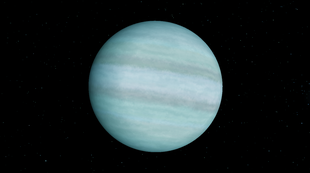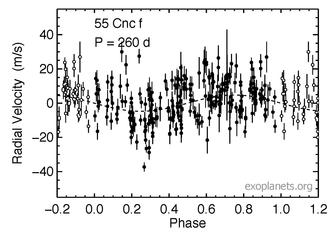Harriot (exoplanet)
|
Exoplanet Harriot |
|
|---|---|
| Artist's impression | |
| Constellation | cancer |
| Position equinox : J2000.0 |
|
| Right ascension | 08h 52m 35.81093s |
| declination | + 28 ° 19 ′ 50.9511 ″ |
| Orbit data | |
| Central star | Copernicus A |
| Major semi-axis | 0.7733 ± 0.001 AU |
| eccentricity | 0.08 +0.102−0.057 |
| Period of circulation | 260.91 ± 0.36 d |
| Further data | |
| Dimensions | 0.1479 +0.0219−0.0093 M J |
| distance | 12.5 pc |
| method | Radial velocity method |
| history | |
| Date of discovery | 2007 |
| Catalog names | |
| 55 Cancri f, HD 75732 f | |
Harriot ( 55 Cancri f ) is an exoplanet orbiting component A of the binary star system Copernicus . It is the fourth planet in the system and the last to be discovered. Due to its high mass , it is probably a gas planet .
discovery
The proof of Harriot is based like with all others of the 55 Cancri system on measurements of the radial velocity of the central star . After analyzing the radial velocity curves, Jack Wisdom suspected the existence of the planet as early as 2005 and announced this in April at the meeting of the American Astronomical Society . The publication in a scientific journal followed a year and a half later. The calculations with the assumption of this fifth planet with an orbit in the large gap between the three narrow planets Janssen, Galileo and Brahe and the rather wide planet Lipperhey enabled an overall stable planetary system with low eccentricities of all planets, as it is according to the generally accepted theories Planet formation is plausible.
Track properties
The planet orbits its star at a distance of approximately 0.781 astronomical units with an eccentricity of 0.2. Its orbit is hardly further than that of Venus . It completes a cycle every 260 days .
Physical Properties
Harriot has a minimum mass of approx. 45.78 earth masses or 0.144 Jupiter masses. So it is at least about half as heavy as Saturn . At present, one can only speculate about its radius, chemical composition and surface temperatures. Most likely it is a gas planet with no solid surface. Based on the orbit and the luminosity of Copernicus A, it could be in the habitable zone , so that liquid water and theoretically life on a potential moon appear possible.
Origin of name
Like all exoplanets, Harriot was originally designated with the star's official name and a lowercase letter, according to the order in which it was discovered. After a public IAU competition , it was given an official name on December 15, 2015, after the English astronomer Thomas Harriot .
swell
- Debra A. Fischer, Geoffrey W. Marcy, R. Paul Butler, et al .: Five Planets Orbiting 55 Cancri. The Astrophysical Journal, 675 (2008), pp. 790-801. doi: 10.1086 / 525512 , arxiv : 0712.3917


